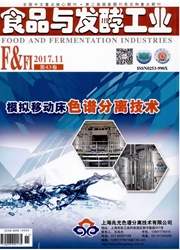

 中文摘要:
中文摘要:
为了探明和保护黑龙江传统发酵豆酱中丰富的乳酸菌资源,以采自黑龙江农家12份传统发酵豆酱样品为试材,从中选择性培养分离出豆酱中的优势乳酸菌疑似菌株,再利用16SrDNA序列分析方法,对其进行鉴定并保藏。结果表明,从黑龙江3个地区采集到的12份样品中共分离出了24株乳酸菌,通过16SrDNA序列分析后共鉴定出5个乳酸菌种,分别是嗜盐四联球菌(rhalopHilus)10株,占总数的41.67%;植物乳杆菌(L.plantarum)6株,占总数的25%;清酒乳杆菌(L.sakei)4株,占总数的16.67%;发酵乳杆菌(L.fermentum)2株,占总数8.33%;短乳杆菌(L.brevi)2株,占总数8.33%。其中,在这3个地区采集的样品中均分离到了嗜盐四联球菌、植物乳杆菌和清酒乳杆菌,嗜盐四联球菌在其中的9份样品中分离到,占总样品数的75%。植物乳杆菌在其中的6份样品中分离到,占总样品数的50%。可以初步推断嗜盐四联球菌和植物乳杆菌是黑龙江传统发酵豆酱中优势乳酸菌菌群。
 英文摘要:
英文摘要:
In order to explore and protect the lactic acid bacteria resources in traditionally fermented soybean pastes from Heilongjiang, in this study, 12 samples of traditionally fermented soybean pastes were collected from Heilongjiang peasant household as test material. Lactic acid bacteria suspected strains in fermented soybean paste were separated through selectively culturing, then were identified using analysis of 16S rDNA sequence. The results showed that 24 strains were separated and identified to be 5 species of lactic acid bacteria respectively. 10 strains belonged to Tetragenococcus halophilus (T. halopHilus), as the largest number of bacteria in samples, accounting for 41.67% of the total. 6 strains belonged to Lactobacillus plantarum ( L. plantarum), accounting for 25 % of the total. 4 strains belonged to Lactobacillus sakei (L. sakei), accounting for 16.67 % of the total. 2 strains belonged to Lactobacillus fermentum (L.fermentum) , accounting for 8.33% of the total. 2 strains belonged to Lactobacillus brevis ( L. brevi) , accounting for 8.33% of the total. Among them, Tetragenococcus halophilus, Lactobacillus plantarum and Lactobacillus sakei were separated in samples from all the three regions. Tetragenococcus halophilus were isolated in 9 samples among them, accounting for 75% of the total samples. Lactobacillus plantarum were isolated in 6 samples among them, accounting for 50% of the total samples. It can be inferred that Tetragenococcus halophilus and Lactobacillus plantarum were the dominant lactic acid bacteria in traditional fermented soybean pastes from Heilongjiang.
 同期刊论文项目
同期刊论文项目
 同项目期刊论文
同项目期刊论文
 Identification of lactic acid bacteria in suancai , a traditional Northeastern Chinese fermented foo
Identification of lactic acid bacteria in suancai , a traditional Northeastern Chinese fermented foo Analysis of Relationship between Sensory Quality and Physiochemical Indexes of Natural fermented Soy
Analysis of Relationship between Sensory Quality and Physiochemical Indexes of Natural fermented Soy Bacterial community involved in traditional fermented soybean paste dajiang made in northeast China.
Bacterial community involved in traditional fermented soybean paste dajiang made in northeast China. 期刊信息
期刊信息
